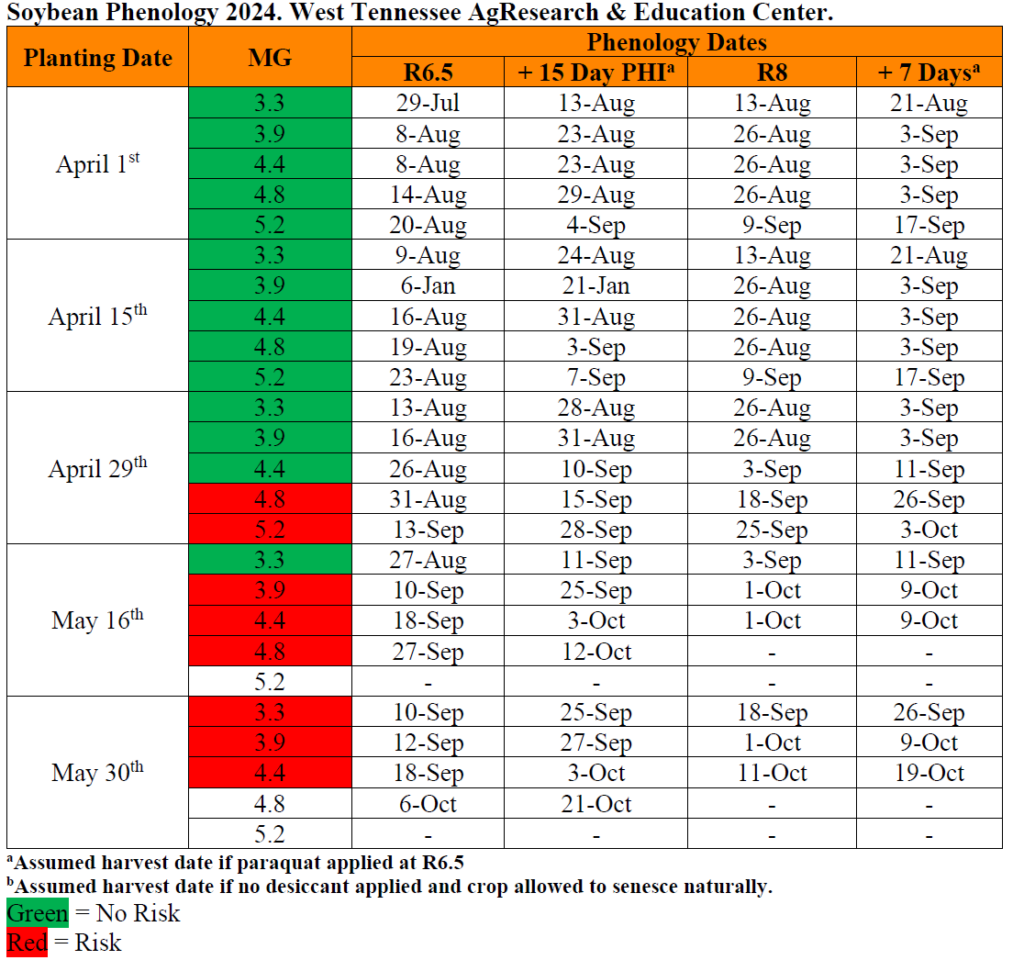I want to enter into this conversation with great humility and respect, as many of our neighbors and fellow Tennesseans have suffered great loss in the wake of Helene. As devastating as crop loss and seed damage can be, many have lost much more.
Nevertheless, as we have returned to soybean harvest following hurricane Helene, myself and producers alike are experiencing a severe decline in soybean seed quality. I have heard reports that elevators are rejecting some loads entirely, and of dockages as high as $2 bushel-1 for others. With average yields and commodity prices not where we’d like for them to be in 2024, this is definitely not the finish we were hoping for.
Several good questions have come in this week that I’d like to discuss and I’ll raise a few more.
Did I plant too early?
In short, no.
Soybean planting dates in Tennessee have been trending earlier in the past few years, and for good reason. Across multiple years, we have seen a demonstrated increase in yield potential both on-farm and in our trials across the state for April vs. May planted soybean. Even within the month of April, earlier has outyielded later. In our work in West TN, we are seeing a yield penalty of approximately a 0.4 bushels per day of delayed planting beginning on April 1st. This translates to 6 bushels for every 2 weeks planting is delayed beginning at that time. This is certainly reason enough to consider early planting each spring if conditions allow.
MG 4 soybeans are the most common selection for full-season beans in Tennessee. Depending on planting date, these were the soybean acres that were at or very near harvest maturity at the time of hurricane Helene’s arrival, but had yet to be harvested.
Based on our work funded by the Tennessee Soybean Promotion Board, below is a brief summary for soybean phenology (growth stage progression) for 2024. A selection of 5 maturity groups were planted at the West Tennessee Research & Education Center at 2-week intervals beginning on April 1st and continued until July 15th. The dates of R6.5 (physiological maturity) and R8 (if no desiccant applied) are shown below. Based on the unique growing conditions of 2024, the purpose of this table is to share what combinations of planting date and maturity group may have been most impacted by the excessive rain associated with hurricane Helene and the corresponding decline in seed quality observed.
Any soybean that was near, at, or past harvest maturity (while not yet out of the field) was certainly prone to seed quality issues following the late September rain. Maturity groups highlighted in green (with their associated planting dates) have harvest dates (+ 15 days after desiccation, or + 7 days past R8) that fall prior to the Sept. 25th.
Regardless of MG, planting dates up to April 15th were likely harvested prior to the rain. Through the end of May, MG’s of up to a 4.4 were also likely harvested in time. However, beginning ~May 1st, MG 4.8+ reached harvest maturity coinciding with the rain. If planting was delayed to the middle of May, only an early MG 3 would have reached harvest time.
It is also certainly possible that later planting dates (June 15 – July 15) will not see seed quality issues. These have yet to be harvested in our trials and we will be sharing that data as it becomes available later this fall and winter.
Did desiccating prior to Helene make grain quality worse?
Possibly.
However, I never recommend to desiccate soybean when a significant weather event is in the + 14-day forecast.
We will have a more 2024-specific answer to this question in the following weeks. Funded by the Tennessee Soybean Promotion Board and the United Soybean Board, we have both desiccation timing (R6, R6.5, R7) and harvest delay (normal, + 2 weeks, +4 weeks) studies that are coming out of the field every week. These studies were likely directly impacted by these rains and will provide a more clear answer to this question.
What, if anything, should I do different next year?
Every decision in life and certainly in agriculture is a risk vs. reward proposition. Mitigating risk is also a huge factor when making decisions as consequential as variety/maturity group and planting date.
However, with respect to planting date specifically, there is too much yield potential on the table to be taken advantage of by planting early to just walk away. Based on the table above, many April planted beans in Tennessee were harvest ready well before the remnants of Helene moved though the state. Late-season storm systems are unpredictable across years. However, mid-season drought conditions usually are not. Selecting a moderately early planting date with a suitable maturity group for our latitude provides the greatest defense against yield-robbing drought.
Did Helene transport any stink bugs to our area?
This is a hard no. I spoke with Extension Entomologist Dr. Sebe Brown to confirm my thoughts on this. Stink bugs do not travel via wind currents. Even in significant storms, their movement is usually “down” from the canopy to the ground, not lateral across regions. I know quite a few stinkbugs are still in fields this year, but this isn’t due to the storm system following Helene.
Please reach out with any more specific questions you have.
Jake


